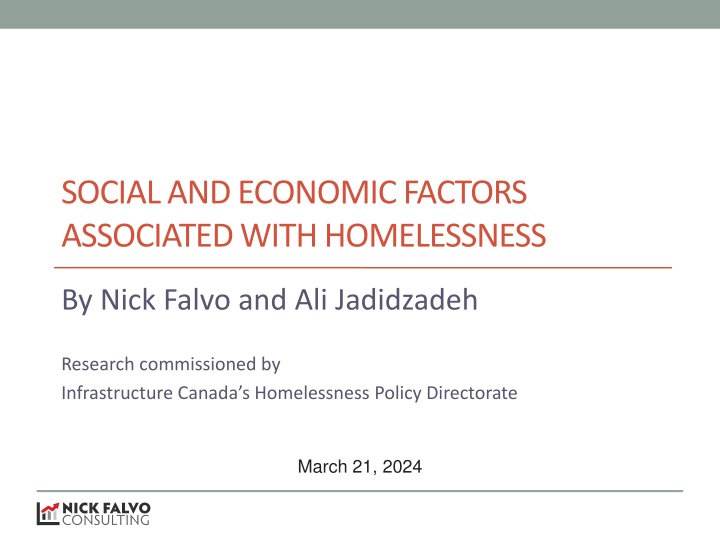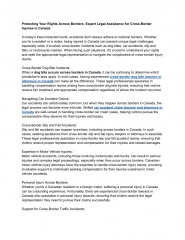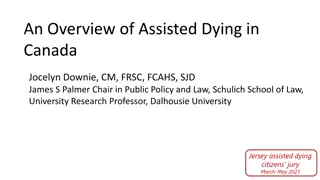
Social and Economic Factors Associated with Homelessness Research
Explore the research commissioned by Infrastructure Canada on social and economic factors linked to homelessness, including a literature review, data assessment, and regression analysis, shedding light on key factors contributing to homelessness in Canada.
Download Presentation

Please find below an Image/Link to download the presentation.
The content on the website is provided AS IS for your information and personal use only. It may not be sold, licensed, or shared on other websites without obtaining consent from the author. If you encounter any issues during the download, it is possible that the publisher has removed the file from their server.
You are allowed to download the files provided on this website for personal or commercial use, subject to the condition that they are used lawfully. All files are the property of their respective owners.
The content on the website is provided AS IS for your information and personal use only. It may not be sold, licensed, or shared on other websites without obtaining consent from the author.
E N D
Presentation Transcript
SOCIAL AND ECONOMIC FACTORS ASSOCIATED WITH HOMELESSNESS By Nick Falvo and Ali Jadidzadeh Research commissioned by Infrastructure Canada s Homelessness Policy Directorate March 21, 2024
Introduction Infrastructure Canada s Homelessness Policy Directorate (HPD) has requested A review of economic and social factors associated with homelessness a literature review an assessment of the availability of Canadian data The identification and estimation of key factors associated with Canadian homelessness. we plan to turn the statistical analysis into a journal article We present regression analysis, where key factors were identified in the literature to estimate their respective contributions to homelessness in Canada.
The lit review We wrote a 36-page lit review (a stand alone document). We d like to make it a public document in the near future, probably with a blog post inviting the reader to dive into it. It has sections on structural causes, systems failures, and individual-level risk factors.
The lit review (contd) Rent levels are consistently found to be predictors of high rates of homelessness (though most of that research is American). Problems with people leaving public systems; however, very little quant analysis.
The lit review (contd) Cross-country, cross-provincial/territorial and cross- municipal comparisons of all of the causes of homelessness is virtually non-existent, with a lack of comparable (i.e., apples to apples) data being a major barrier to such research.
The assessment of data We ve written a 19-page stand alone document. Essentially, if a researcher or team of researchers (or grad student) wants to do a regression analysis of the type we ve done, what data would they use? This document sheds light on that.
The assessment of data (contd) Kudos to Infrastructure Canada for wanting us to create such a document for others! We d be happy to make this available at the appropriate time (perhaps when there s a public release of the regression results).
The regression analysis North American research has consistently found the major structural cause of homelessness to be a lack of alignment between the availability of low-cost housing and incomes. However, how this is measured varies across studies, and other factors also play important roles.
Objective In this study of shelter admissions in Canada, we uncover a complex web of relationships between socio-economic factors and emergency shelter utilization. Monthly data from January 2012 to December 2019 Three regions: Ontario, Atlantic provinces, and Western provinces Socio-economic factors include: Labour market factors Housing market factors Social assistance services Weather-related factors
Data Shelter Admissions: Monthly time series from January 2012 to December 2019 (T=96) The number of distinct admissions in Ontario, the Atlantic provinces, and the Western provinces Single adult shelters: Ontario and the Atlantic provinces (NL, PEI, NS, NB) Single adults and family shelters: Western provinces (MB, SK, AB, BC) Age breakdowns: Youth (ages 16 to 24 years) Single adults (ages 25 years and older)
Data Monthly Flow of Emergency Shelter Utilization in Ontario: January 2012 - December 2019 Total Admissions 16 to 24 years 25 years and over 9,000 8,000 7,000 6,000 5,000 4,000 3,000 2,000 1,000 0 2012/01 2012/12 2013/11 2014/10 2015/09 2016/08 2017/07 2018/06 2019/05
Data Monthly Flow of Emergency Shelter Utilization in Atlantic Provinces (NL, PEI, NS, NB): January 2012 - December 2019 Total Admissions 16 to 24 years 25 years and over 900 800 700 600 500 400 300 200 100 0 2012/01 2012/12 2013/11 2014/10 2015/09 2016/08 2017/07 2018/06 2019/05
Data Monthly Flow of Emergency Shelter Utilization in Western Provinces (MB, SK, AB, BC): January 2012 - December 2019 Total Admissions 16 to 24 years 25 years and over 16,000 14,000 12,000 10,000 8,000 6,000 4,000 2,000 0 2012/01 2012/12 2013/11 2014/10 2015/09 2016/08 2017/07 2018/06 2019/05
Data Socio-Economic Variables labour market Unemployment rate (%) Duration of unemployment (weeks) Real minimum wage ($CND) Housing market Real linearly interpolated bachelor/one bedroom rent, 1st quartile ($CND) Interpolated vacancy rate for bachelor/one-bedroom units (%) Social assistance services Real social assistance income, ($CND/month) Social assistance case load rate (%) Weather-related variables days with negative temperature days with negative temperature and positive precipitation
Data Summary Statistics for Socioeconomic Factors in Ontario: January 2012 - December 2019 Std. Mean Deviation Minimum Maximum Labour market Unemployment rate (%) Duration of unemployment (weeks) Real minimum wage ($CND) Social services Real social assistance income, ($CND/month) Social assistance case load rate (%) Housing market Real linearly interpolated bachelor rent, 1st quartile 6.69 19.82 8.98 0.88 2.35 0.78 5.20 14.60 8.08 8.20 23.60 10.51 578.28 5.42 17.66 0.05 549.29 5.30 603.48 5.52 535.29 19.05 490.20 576.20 ($CND) Interpolated vacancy rate for bachelor units (%) Weather Days with negative temperature each month Days with negative temperature and positive precipitation 2.40 0.22 1.90 3.08 8.63 4.54 10.44 6.04 0.00 0.00 29.00 20.00 each month
Data Summary Statistics for Socioeconomic Factors in Atlantic Provinces (NL, PEI, NS, NB): January 2012 - December 2019 Std. Mean Deviation Minimum Maximum Labour market Unemployment rate (%) Duration of unemployment (weeks) Real minimum wage ($CND) Social services Real social assistance income, ($CND/month) Social assistance case load rate (%) Housing market Real linearly interpolated bachelor rent, 1st quartile 10.38 16.99 8.13 0.64 1.30 0.15 8.78 14.18 7.85 11.65 20.98 8.47 538.17 4.00 13.08 0.15 523.93 3.66 572.39 4.33 399.17 7.96 375.23 412.34 ($CND) Interpolated vacancy rate for bachelor units (%) 4.50 0.91 2.71 5.70
Data Summary Statistics for Socioeconomic Factors in Western Provinces (MB, SK, AB, BC): January 2012 - December 2019 Std. Mean Deviation Minimum Maximum Labour market Unemployment rate (%) Duration of unemployment (weeks) Real minimum wage ($CND) Social services Real social assistance income, ($CND/month) Social assistance case load rate (%) Housing market Real linearly interpolated bachelor rent, 1st quartile 5.75 17.06 8.45 0.53 1.75 0.43 4.73 14.15 7.85 7.00 20.90 9.39 1,226.52 2.53 74.72 0.19 1,129.10 2.28 1,351.58 2.82 601.27 14.45 566.40 620.52 ($CND) Interpolated vacancy rate for bachelor units (%) 3.60 1.22 1.94 5.10
Regression Model We employ Ordinary Least Square (OLS) regressions to estimate the following models: 11 ? + ?Trend?+ ??(??) = ? + x? ??Month?+ ?? ? ?=1 ??(??) represents the natural logarithm of dependent variable: aggregate admissions, single adult admissions, and youth admissions at time ? x? denotes the vector of socio-economic variables listed in the previous slide Month? incorporates 11-month dummies to account for seasonality ?? is the residual The parameters of the model to be estimated are denoted by ?, ?,? and ?s
Empirical Evidence: Ontario Single Adult (25 years and older) Youth All (16 to 24 years) Std. Error 4.624 Std. Error 4.799 * Std. Error 5.822 Dependent variable: Admissions, log Intercept Estimate 9.175 Estimate 10.772 Estimate -3.387 Labour market Unemployment rate (%) -0.016 0.019 -0.012 0.020 -0.043 0.024 Duration of unemployment (weeks), log 0.157 0.067 * 0.144 0.069 * 0.239 0.084 ** Real minimum wage ($CND), log 0.449 0.113 *** 0.487 0.117 *** 0.238 0.142 Social services Real social assistance income, ($CND/month), log -1.885 0.849 * -2.143 0.881 * -0.192 1.069 Social assistance case load rate (%) 0.329 0.214 0.287 0.222 0.503 0.270 Housing market Real linearly interpolated rent, 1st quartile ($CND), log Interpolated vacancy rate for rental units (%) 1.358 0.422 ** 1.350 0.438 ** 1.315 0.531 * 0.012 0.028 0.005 0.029 0.052 0.035 Weather Days with negative temperature and positive precipitation 0.001 -0.004 0.002* -0.003 0.001 -0.003 Time trend Yes Yes Yes Month dummies Yes Yes Yes Adjusted R2 0.768 0.862 0.770 Number of observations 96 96 96 Degrees of freedom 75 75 75 Note: Asterisks denote coefficients that are statistically different from zero at the 0.1 percent (***), 1 percent (**), 5 percent (*) and 10 percent ( ) levels.
Empirical Evidence: Atlantic Provinces Single Adult (25 years and older) Youth All (16 to 24 years) Std. Error 4.316 ** Std. Error Std. Error Dependent variable: Admissions for single adults, log Intercept Estimate 12.403 Estimate 14.446 5.234 ** Estimate 0.297 6.396 Labour market Unemployment rate (%) -0.001 0.014 -0.003 0.017 0.006 0.021 Duration of unemployment (weeks), log -0.192 0.088 * -0.172 0.107 -0.283 0.131 * Real minimum wage ($CND), log 2.102 0.632 ** 2.762 0.766 *** -0.444 0.936 Social services Real social assistance income, ($CND/month), log -1.389 0.452 ** -1.968 0.548 *** 0.765 0.669 Social assistance case load rate (%) -0.657 0.173 *** -0.654 0.209 ** -0.607 0.256 * Housing market Real linearly interpolated rent, 1st quartile ($CND), log 0.320 0.480 0.309 0.583 0.700 0.712 Interpolated vacancy rate for rental units (%) -0.032 0.013 * -0.038 0.016 * -0.007 0.019 Time trend Yes Yes Yes Month dummies Yes Yes Yes Adjusted R2 0.519 0.600 0.765 Number of observations 96 96 96 Degrees of freedom 76 76 76 Note: Asterisks denote coefficients that are statistically different from zero at the 0.1 percent (***), 1 percent (**), 5 percent (*) and 10 percent ( ) levels.
Empirical Evidence: Western Provinces Single Adult (25 years and older) Youth All (16 to 24 years) Std. Error Std. Error Std. Error Dependent variable: Admissions for youth, log Intercept Estimate Estimate Estimate -3.613 7.564 -2.628 7.428 -19.482 9.991 Labour market Unemployment rate (%) -0.081 0.029 ** -0.083 0.028 ** -0.049 0.038 Duration of unemployment (weeks), log 0.012 0.091 0.002 0.090 0.138 0.121 Real minimum wage ($CND), log -0.611 0.718 -0.592 0.705 -0.922 0.948 Social services Real social assistance income, ($CND/month), log 0.017 0.619 0.041 0.608 -0.322 0.817 Social assistance case load rate (%) -0.671 0.234 ** -0.685 0.229 ** -0.503 0.308 Housing market Real linearly interpolated rent, 1st quartile ($CND), log 2.473 0.963 * 2.281 0.946 * 4.938 1.273 *** Interpolated vacancy rate for rental units (%) 0.138 0.046 ** 0.143 0.045 ** 0.088 0.061 Time trend Yes Yes Yes Month dummies Yes Yes Yes Adjusted R2 0.667 0.699 0.699 Number of observations 96 96 96 Degrees of freedom 76 76 76 Note: Asterisks denote coefficients that are statistically different from zero at the 0.1 percent (***), 1 percent (**), 5 percent (*) and 10 percent ( ) levels.
Conclusion The labour market factors, including the unemployment rate, duration of unemployment, and real minimum wage, do not exhibit a consistent impact across regions and populations. We consider social assistance services, which encompass monthly real social assistance income and the social assistance case load rate. These factors have substantial impacts on the number of admissions. Analyzing the impact of the housing market on admissions reveals notable regional differences. The housing market variables includes monthly real rent for affordable units and vacancy rate. Regarding weather-related factors, they all exhibit a minor negative influence on shelter admissions across different groups.
Empirical Evidence: Total Admissions Ontario Atlantic West Std. Error 4.624 Std. Error 4.316 ** Std. Error 7.564 Dependent variable: Total admissions, log Intercept Estimate 9.175 Estimate 12.403 Estimate -3.613 Labour market Unemployment rate (%) -0.016 0.019 -0.001 0.014 -0.081 0.029 ** 0.091 Duration of unemployment (weeks), log 0.157 0.067 * 0.113 *** -0.192 0.088 * 0.632 ** 0.012 Real minimum wage ($CND), log 0.449 2.102 -0.611 0.718 Social services Real social assistance income, ($CND/month), log -1.885 0.849 * 0.214 -1.389 0.452 ** 0.173 *** 0.017 0.619 Social assistance case load rate (%) 0.329 -0.657 -0.671 0.234 ** Housing market Real linearly interpolated rent, 1st quartile ($CND), log Interpolated vacancy rate for rental units (%) 1.358 0.422 ** 0.028 0.320 0.480 2.473 0.963 * 0.046 ** 0.012 -0.032 0.013 * 0.138 Weather Days with negative temperature and positive precipitation -0.003 0.001 Time trend Yes Yes Yes Month dummies Yes Yes Yes Adjusted R2 0.768 0.519 0.667 Number of observations 96 96 96 Degrees of freedom 75 76 76 Note: Asterisks denote coefficients that are statistically different from zero at the 0.1 percent (***), 1 percent (**), 5 percent (*) and 10 percent ( ) levels.
Empirical Evidence: Admissions for single adults Ontario Atlantic West Std. Error Std. Error Std. Error Dependent variable: Admissions for single adults, log Intercept Estimate 10.772 4.799 * Estimate 14.446 5.234 ** Estimate -2.628 7.428 Labour market Unemployment rate (%) -0.012 0.020 -0.003 0.017 -0.083 0.028 ** Duration of unemployment (weeks), log 0.144 0.069 * -0.172 0.107 0.002 0.090 Real minimum wage ($CND), log 0.487 0.117 *** 2.762 0.766 *** -0.592 0.705 Social services Real social assistance income, ($CND/month), log -2.143 0.881 * -1.968 0.548 *** 0.041 0.608 Social assistance case load rate (%) 0.287 0.222 -0.654 0.209 ** -0.685 0.229 ** Housing market Real linearly interpolated rent, 1st quartile ($CND), log 1.350 0.438 ** 0.309 0.583 2.281 0.946 * Interpolated vacancy rate for rental units (%) 0.005 0.029 -0.038 0.016 * 0.143 0.045 ** Weather Days with negative temperature and positive precipitation -0.003 0.001 Time trend Yes Yes Yes Month dummies Yes Yes Yes Adjusted R2 0.862 0.600 0.699 Number of observations 96 96 96 Degrees of freedom 75 76 76 Note: Asterisks denote coefficients that are statistically different from zero at the 0.1 percent (***), 1 percent (**), 5 percent (*) and 10 percent ( ) levels.
Empirical Evidence: Admissions for youth Ontario Atlantic West Std. Error Std. Error 6.396 Std. Error 9.991 Dependent variable: Admissions for youth, log Intercept Estimate -3.387 Estimate 0.297 Estimate -19.482 5.822 Labour market Unemployment rate (%) -0.043 0.024 0.006 0.021 -0.049 0.038 Duration of unemployment (weeks), log 0.239 0.084 ** -0.283 0.131 * 0.138 0.121 Real minimum wage ($CND), log 0.238 0.142 -0.444 0.936 -0.922 0.948 Social services Real social assistance income, ($CND/month), log -0.192 1.069 0.765 0.669 -0.322 0.817 Social assistance case load rate (%) 0.503 0.270 -0.607 0.256 * -0.503 0.308 Housing market Real linearly interpolated rent, 1st quartile ($CND), log 1.315 0.531 * 0.700 0.712 4.938 1.273 *** Interpolated vacancy rate for rental units (%) 0.052 0.035 -0.007 0.019 0.088 0.061 Weather Days with negative temperature and positive precipitation -0.004 0.002 * Time trend Yes Yes Yes Month dummies Yes Yes Yes Adjusted R2 0.770 0.765 0.699 Number of observations 96 96 96 Degrees of freedom 75 76 76 Note: Asterisks denote coefficients that are statistically different from zero at the 0.1 percent (***), 1 percent (**), 5 percent (*) and 10 percent ( ) levels.






















